Detailed Analysis: Contract and Negligence in Business Law Report
VerifiedAdded on 2020/07/22
|13
|4560
|76
Report
AI Summary
This report analyzes key aspects of contract and negligence within a business context. It begins by explaining contract formation, including essential elements like offer, acceptance, and consideration, and explores the impact of contracts on business operations. The report then delves into various contract terms, such as conditions, warranties, and exemption clauses, and applies these concepts to given business scenarios. Furthermore, it contrasts contractual liability with tort liability, specifically focusing on negligence and vicarious liability, providing examples to illustrate how liability can arise and how businesses can be held responsible for the actions of their employees. The report concludes by applying the principles of negligence and vicarious liability to additional business situations, offering a comprehensive overview of these crucial legal concepts.
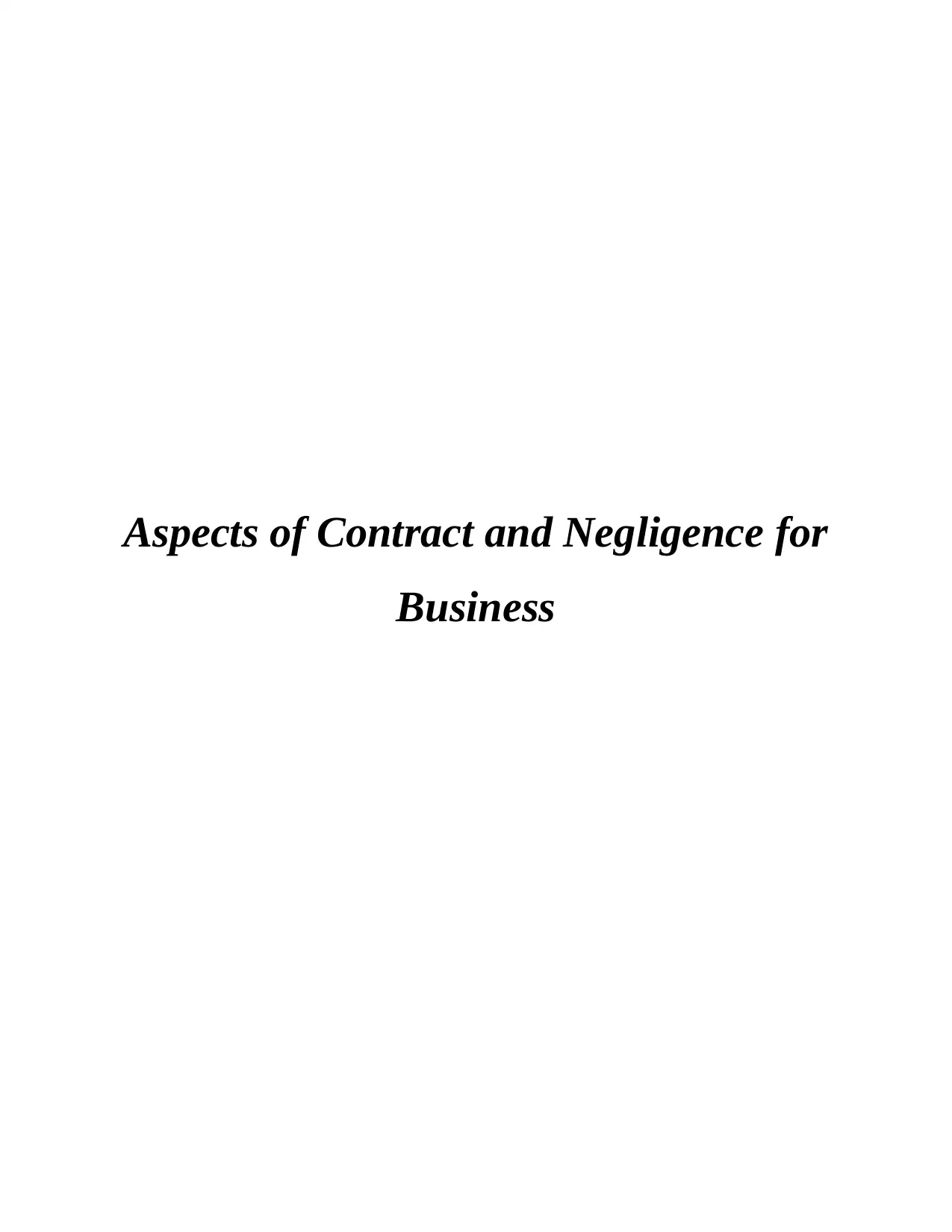
Aspects of Contract and Negligence for
Business
Business
Paraphrase This Document
Need a fresh take? Get an instant paraphrase of this document with our AI Paraphraser
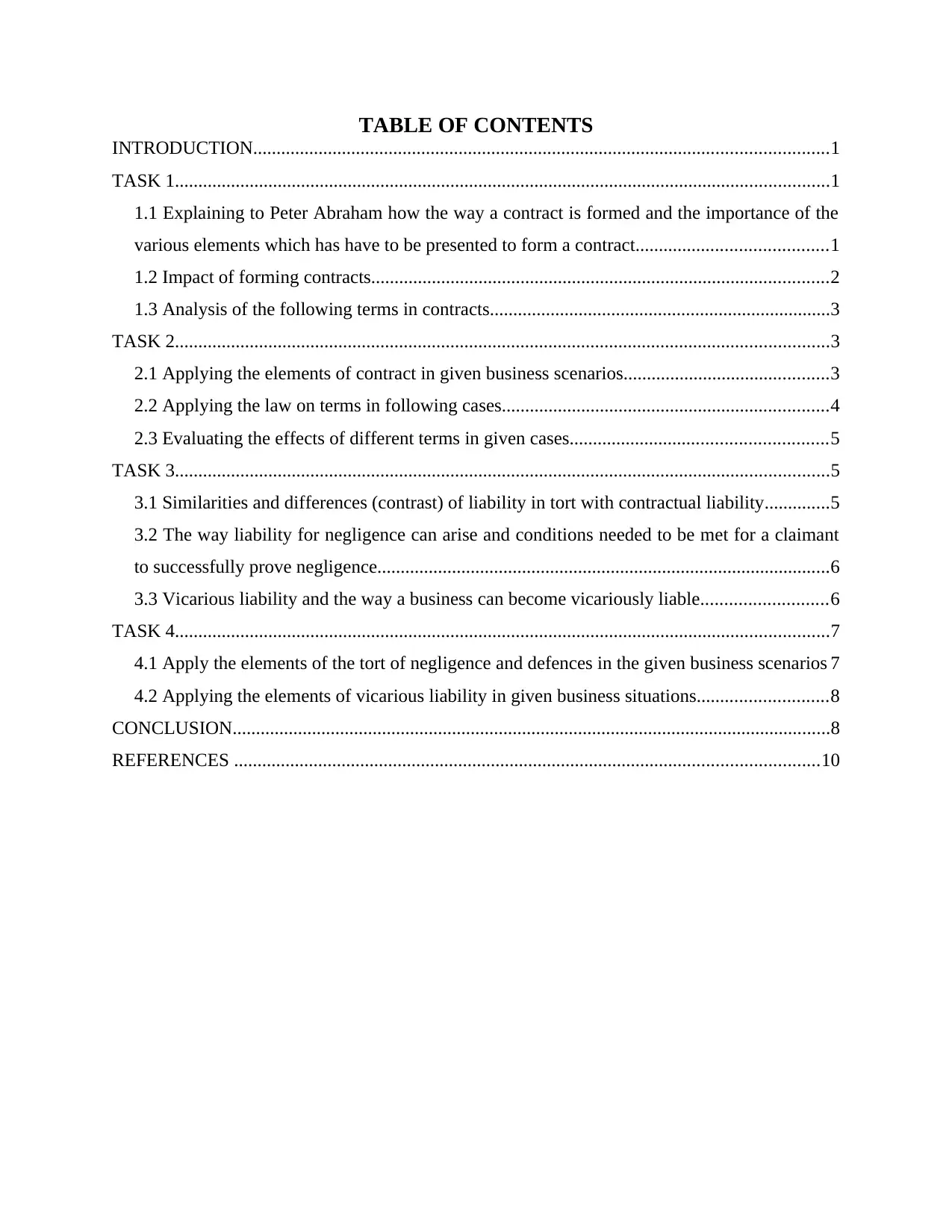
TABLE OF CONTENTS
INTRODUCTION...........................................................................................................................1
TASK 1............................................................................................................................................1
1.1 Explaining to Peter Abraham how the way a contract is formed and the importance of the
various elements which has have to be presented to form a contract.........................................1
1.2 Impact of forming contracts..................................................................................................2
1.3 Analysis of the following terms in contracts.........................................................................3
TASK 2............................................................................................................................................3
2.1 Applying the elements of contract in given business scenarios............................................3
2.2 Applying the law on terms in following cases......................................................................4
2.3 Evaluating the effects of different terms in given cases.......................................................5
TASK 3............................................................................................................................................5
3.1 Similarities and differences (contrast) of liability in tort with contractual liability..............5
3.2 The way liability for negligence can arise and conditions needed to be met for a claimant
to successfully prove negligence.................................................................................................6
3.3 Vicarious liability and the way a business can become vicariously liable...........................6
TASK 4............................................................................................................................................7
4.1 Apply the elements of the tort of negligence and defences in the given business scenarios 7
4.2 Applying the elements of vicarious liability in given business situations............................8
CONCLUSION................................................................................................................................8
REFERENCES .............................................................................................................................10
INTRODUCTION...........................................................................................................................1
TASK 1............................................................................................................................................1
1.1 Explaining to Peter Abraham how the way a contract is formed and the importance of the
various elements which has have to be presented to form a contract.........................................1
1.2 Impact of forming contracts..................................................................................................2
1.3 Analysis of the following terms in contracts.........................................................................3
TASK 2............................................................................................................................................3
2.1 Applying the elements of contract in given business scenarios............................................3
2.2 Applying the law on terms in following cases......................................................................4
2.3 Evaluating the effects of different terms in given cases.......................................................5
TASK 3............................................................................................................................................5
3.1 Similarities and differences (contrast) of liability in tort with contractual liability..............5
3.2 The way liability for negligence can arise and conditions needed to be met for a claimant
to successfully prove negligence.................................................................................................6
3.3 Vicarious liability and the way a business can become vicariously liable...........................6
TASK 4............................................................................................................................................7
4.1 Apply the elements of the tort of negligence and defences in the given business scenarios 7
4.2 Applying the elements of vicarious liability in given business situations............................8
CONCLUSION................................................................................................................................8
REFERENCES .............................................................................................................................10
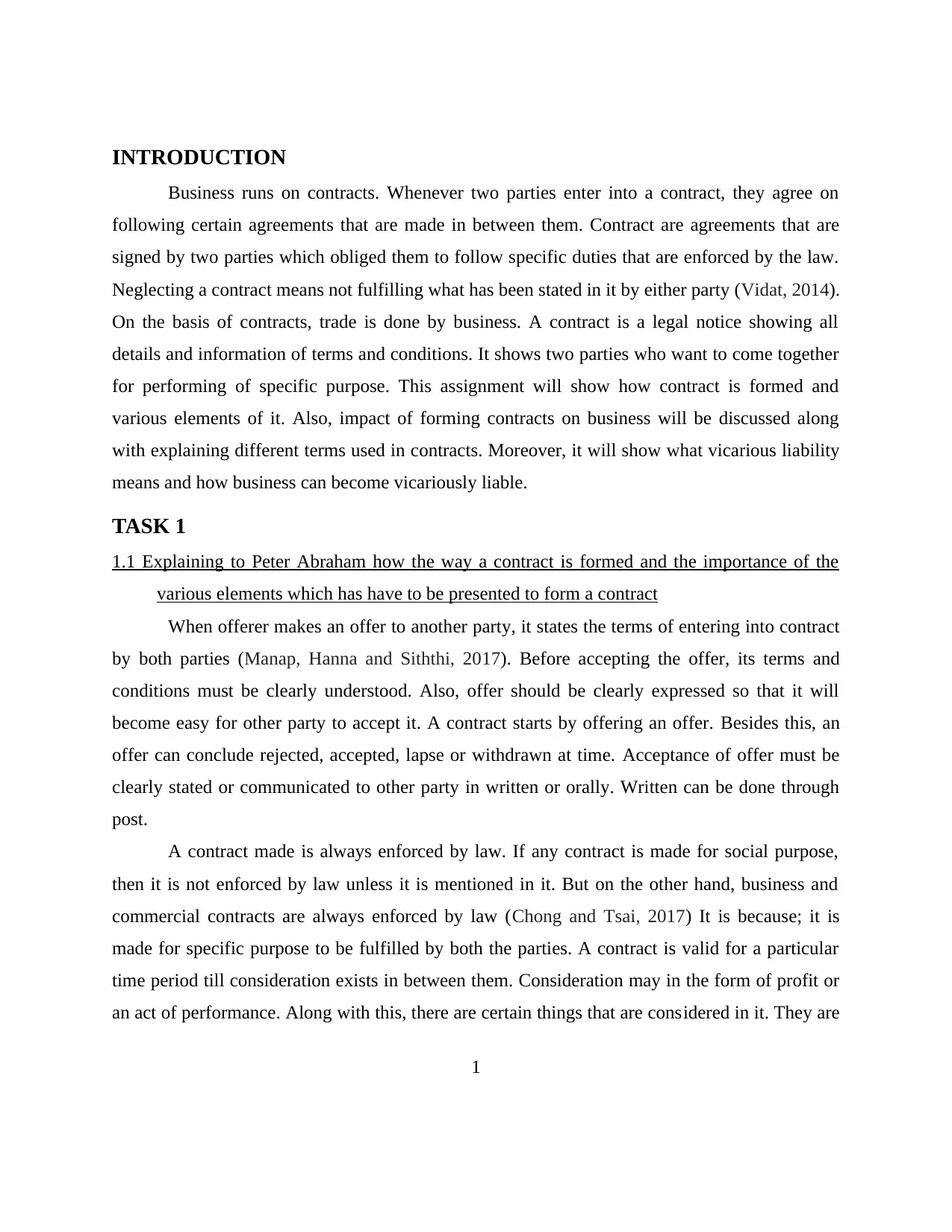
INTRODUCTION
Business runs on contracts. Whenever two parties enter into a contract, they agree on
following certain agreements that are made in between them. Contract are agreements that are
signed by two parties which obliged them to follow specific duties that are enforced by the law.
Neglecting a contract means not fulfilling what has been stated in it by either party (Vidat, 2014).
On the basis of contracts, trade is done by business. A contract is a legal notice showing all
details and information of terms and conditions. It shows two parties who want to come together
for performing of specific purpose. This assignment will show how contract is formed and
various elements of it. Also, impact of forming contracts on business will be discussed along
with explaining different terms used in contracts. Moreover, it will show what vicarious liability
means and how business can become vicariously liable.
TASK 1
1.1 Explaining to Peter Abraham how the way a contract is formed and the importance of the
various elements which has have to be presented to form a contract
When offerer makes an offer to another party, it states the terms of entering into contract
by both parties (Manap, Hanna and Siththi, 2017). Before accepting the offer, its terms and
conditions must be clearly understood. Also, offer should be clearly expressed so that it will
become easy for other party to accept it. A contract starts by offering an offer. Besides this, an
offer can conclude rejected, accepted, lapse or withdrawn at time. Acceptance of offer must be
clearly stated or communicated to other party in written or orally. Written can be done through
post.
A contract made is always enforced by law. If any contract is made for social purpose,
then it is not enforced by law unless it is mentioned in it. But on the other hand, business and
commercial contracts are always enforced by law (Chong and Tsai, 2017) It is because; it is
made for specific purpose to be fulfilled by both the parties. A contract is valid for a particular
time period till consideration exists in between them. Consideration may in the form of profit or
an act of performance. Along with this, there are certain things that are considered in it. They are
1
Business runs on contracts. Whenever two parties enter into a contract, they agree on
following certain agreements that are made in between them. Contract are agreements that are
signed by two parties which obliged them to follow specific duties that are enforced by the law.
Neglecting a contract means not fulfilling what has been stated in it by either party (Vidat, 2014).
On the basis of contracts, trade is done by business. A contract is a legal notice showing all
details and information of terms and conditions. It shows two parties who want to come together
for performing of specific purpose. This assignment will show how contract is formed and
various elements of it. Also, impact of forming contracts on business will be discussed along
with explaining different terms used in contracts. Moreover, it will show what vicarious liability
means and how business can become vicariously liable.
TASK 1
1.1 Explaining to Peter Abraham how the way a contract is formed and the importance of the
various elements which has have to be presented to form a contract
When offerer makes an offer to another party, it states the terms of entering into contract
by both parties (Manap, Hanna and Siththi, 2017). Before accepting the offer, its terms and
conditions must be clearly understood. Also, offer should be clearly expressed so that it will
become easy for other party to accept it. A contract starts by offering an offer. Besides this, an
offer can conclude rejected, accepted, lapse or withdrawn at time. Acceptance of offer must be
clearly stated or communicated to other party in written or orally. Written can be done through
post.
A contract made is always enforced by law. If any contract is made for social purpose,
then it is not enforced by law unless it is mentioned in it. But on the other hand, business and
commercial contracts are always enforced by law (Chong and Tsai, 2017) It is because; it is
made for specific purpose to be fulfilled by both the parties. A contract is valid for a particular
time period till consideration exists in between them. Consideration may in the form of profit or
an act of performance. Along with this, there are certain things that are considered in it. They are
1
⊘ This is a preview!⊘
Do you want full access?
Subscribe today to unlock all pages.

Trusted by 1+ million students worldwide
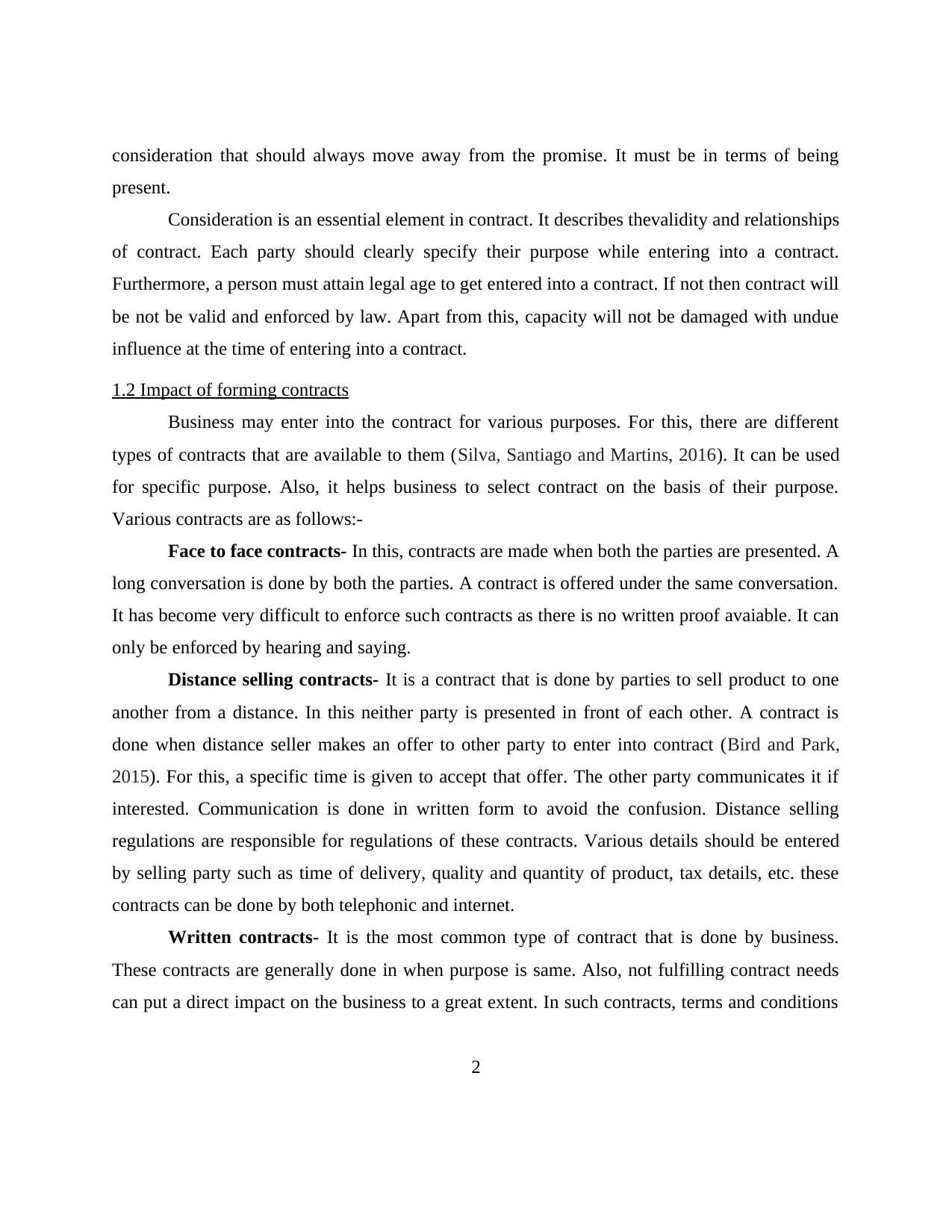
consideration that should always move away from the promise. It must be in terms of being
present.
Consideration is an essential element in contract. It describes thevalidity and relationships
of contract. Each party should clearly specify their purpose while entering into a contract.
Furthermore, a person must attain legal age to get entered into a contract. If not then contract will
be not be valid and enforced by law. Apart from this, capacity will not be damaged with undue
influence at the time of entering into a contract.
1.2 Impact of forming contracts
Business may enter into the contract for various purposes. For this, there are different
types of contracts that are available to them (Silva, Santiago and Martins, 2016). It can be used
for specific purpose. Also, it helps business to select contract on the basis of their purpose.
Various contracts are as follows:-
Face to face contracts- In this, contracts are made when both the parties are presented. A
long conversation is done by both the parties. A contract is offered under the same conversation.
It has become very difficult to enforce such contracts as there is no written proof avaiable. It can
only be enforced by hearing and saying.
Distance selling contracts- It is a contract that is done by parties to sell product to one
another from a distance. In this neither party is presented in front of each other. A contract is
done when distance seller makes an offer to other party to enter into contract (Bird and Park,
2015). For this, a specific time is given to accept that offer. The other party communicates it if
interested. Communication is done in written form to avoid the confusion. Distance selling
regulations are responsible for regulations of these contracts. Various details should be entered
by selling party such as time of delivery, quality and quantity of product, tax details, etc. these
contracts can be done by both telephonic and internet.
Written contracts- It is the most common type of contract that is done by business.
These contracts are generally done in when purpose is same. Also, not fulfilling contract needs
can put a direct impact on the business to a great extent. In such contracts, terms and conditions
2
present.
Consideration is an essential element in contract. It describes thevalidity and relationships
of contract. Each party should clearly specify their purpose while entering into a contract.
Furthermore, a person must attain legal age to get entered into a contract. If not then contract will
be not be valid and enforced by law. Apart from this, capacity will not be damaged with undue
influence at the time of entering into a contract.
1.2 Impact of forming contracts
Business may enter into the contract for various purposes. For this, there are different
types of contracts that are available to them (Silva, Santiago and Martins, 2016). It can be used
for specific purpose. Also, it helps business to select contract on the basis of their purpose.
Various contracts are as follows:-
Face to face contracts- In this, contracts are made when both the parties are presented. A
long conversation is done by both the parties. A contract is offered under the same conversation.
It has become very difficult to enforce such contracts as there is no written proof avaiable. It can
only be enforced by hearing and saying.
Distance selling contracts- It is a contract that is done by parties to sell product to one
another from a distance. In this neither party is presented in front of each other. A contract is
done when distance seller makes an offer to other party to enter into contract (Bird and Park,
2015). For this, a specific time is given to accept that offer. The other party communicates it if
interested. Communication is done in written form to avoid the confusion. Distance selling
regulations are responsible for regulations of these contracts. Various details should be entered
by selling party such as time of delivery, quality and quantity of product, tax details, etc. these
contracts can be done by both telephonic and internet.
Written contracts- It is the most common type of contract that is done by business.
These contracts are generally done in when purpose is same. Also, not fulfilling contract needs
can put a direct impact on the business to a great extent. In such contracts, terms and conditions
2
Paraphrase This Document
Need a fresh take? Get an instant paraphrase of this document with our AI Paraphraser
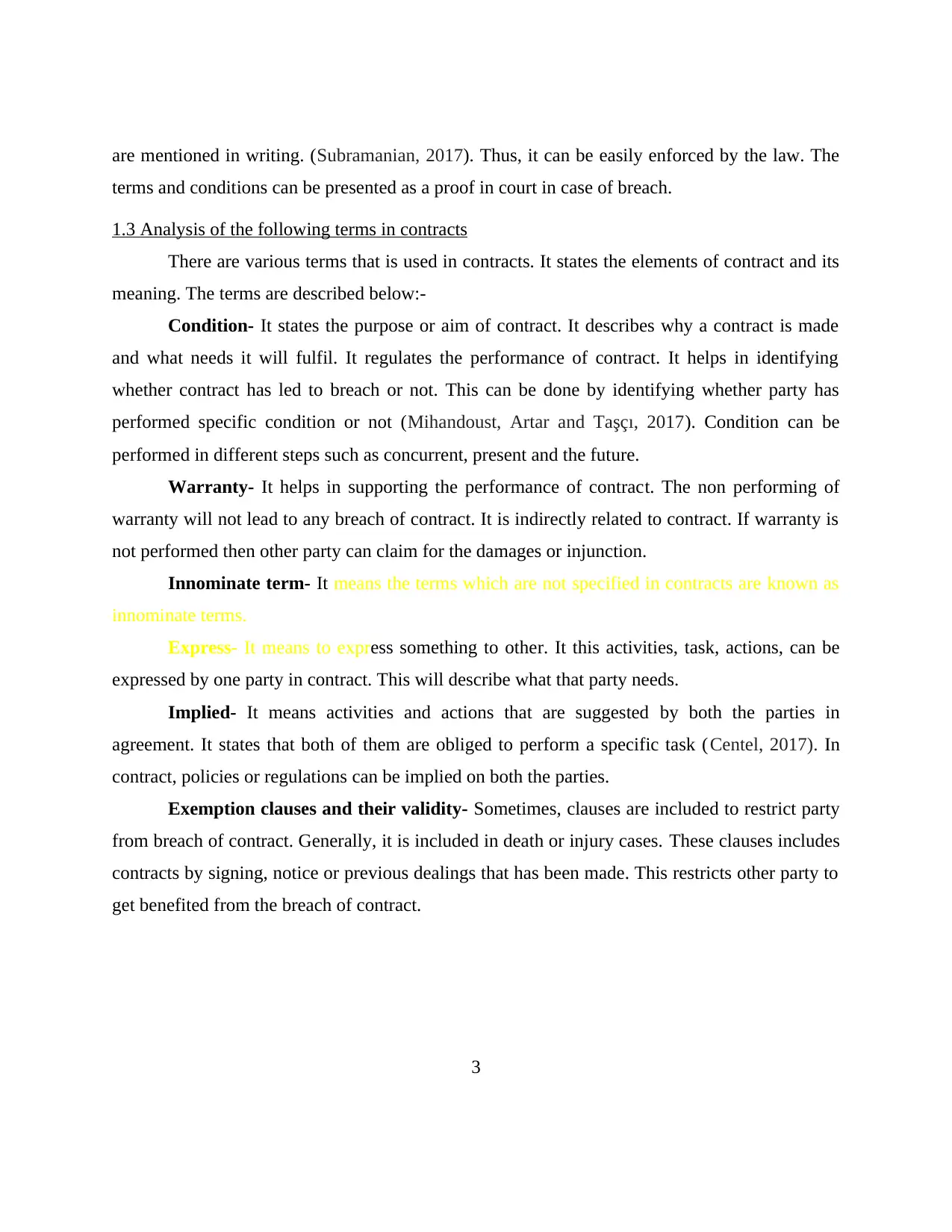
are mentioned in writing. (Subramanian, 2017). Thus, it can be easily enforced by the law. The
terms and conditions can be presented as a proof in court in case of breach.
1.3 Analysis of the following terms in contracts
There are various terms that is used in contracts. It states the elements of contract and its
meaning. The terms are described below:-
Condition- It states the purpose or aim of contract. It describes why a contract is made
and what needs it will fulfil. It regulates the performance of contract. It helps in identifying
whether contract has led to breach or not. This can be done by identifying whether party has
performed specific condition or not (Mihandoust, Artar and Taşçı, 2017). Condition can be
performed in different steps such as concurrent, present and the future.
Warranty- It helps in supporting the performance of contract. The non performing of
warranty will not lead to any breach of contract. It is indirectly related to contract. If warranty is
not performed then other party can claim for the damages or injunction.
Innominate term- It means the terms which are not specified in contracts are known as
innominate terms.
Express- It means to express something to other. It this activities, task, actions, can be
expressed by one party in contract. This will describe what that party needs.
Implied- It means activities and actions that are suggested by both the parties in
agreement. It states that both of them are obliged to perform a specific task (Centel, 2017). In
contract, policies or regulations can be implied on both the parties.
Exemption clauses and their validity- Sometimes, clauses are included to restrict party
from breach of contract. Generally, it is included in death or injury cases. These clauses includes
contracts by signing, notice or previous dealings that has been made. This restricts other party to
get benefited from the breach of contract.
3
terms and conditions can be presented as a proof in court in case of breach.
1.3 Analysis of the following terms in contracts
There are various terms that is used in contracts. It states the elements of contract and its
meaning. The terms are described below:-
Condition- It states the purpose or aim of contract. It describes why a contract is made
and what needs it will fulfil. It regulates the performance of contract. It helps in identifying
whether contract has led to breach or not. This can be done by identifying whether party has
performed specific condition or not (Mihandoust, Artar and Taşçı, 2017). Condition can be
performed in different steps such as concurrent, present and the future.
Warranty- It helps in supporting the performance of contract. The non performing of
warranty will not lead to any breach of contract. It is indirectly related to contract. If warranty is
not performed then other party can claim for the damages or injunction.
Innominate term- It means the terms which are not specified in contracts are known as
innominate terms.
Express- It means to express something to other. It this activities, task, actions, can be
expressed by one party in contract. This will describe what that party needs.
Implied- It means activities and actions that are suggested by both the parties in
agreement. It states that both of them are obliged to perform a specific task (Centel, 2017). In
contract, policies or regulations can be implied on both the parties.
Exemption clauses and their validity- Sometimes, clauses are included to restrict party
from breach of contract. Generally, it is included in death or injury cases. These clauses includes
contracts by signing, notice or previous dealings that has been made. This restricts other party to
get benefited from the breach of contract.
3
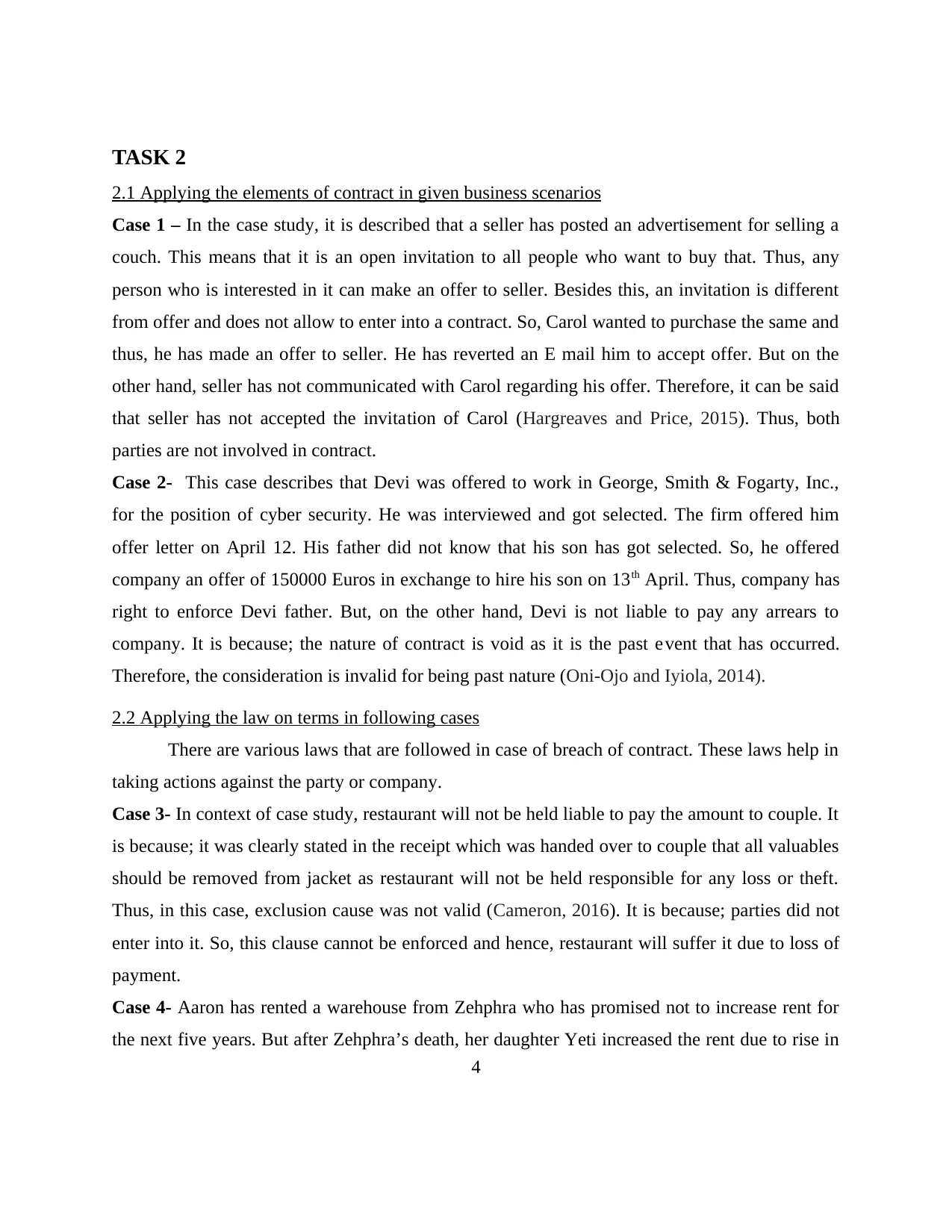
TASK 2
2.1 Applying the elements of contract in given business scenarios
Case 1 – In the case study, it is described that a seller has posted an advertisement for selling a
couch. This means that it is an open invitation to all people who want to buy that. Thus, any
person who is interested in it can make an offer to seller. Besides this, an invitation is different
from offer and does not allow to enter into a contract. So, Carol wanted to purchase the same and
thus, he has made an offer to seller. He has reverted an E mail him to accept offer. But on the
other hand, seller has not communicated with Carol regarding his offer. Therefore, it can be said
that seller has not accepted the invitation of Carol (Hargreaves and Price, 2015). Thus, both
parties are not involved in contract.
Case 2- This case describes that Devi was offered to work in George, Smith & Fogarty, Inc.,
for the position of cyber security. He was interviewed and got selected. The firm offered him
offer letter on April 12. His father did not know that his son has got selected. So, he offered
company an offer of 150000 Euros in exchange to hire his son on 13th April. Thus, company has
right to enforce Devi father. But, on the other hand, Devi is not liable to pay any arrears to
company. It is because; the nature of contract is void as it is the past event that has occurred.
Therefore, the consideration is invalid for being past nature (Oni-Ojo and Iyiola, 2014).
2.2 Applying the law on terms in following cases
There are various laws that are followed in case of breach of contract. These laws help in
taking actions against the party or company.
Case 3- In context of case study, restaurant will not be held liable to pay the amount to couple. It
is because; it was clearly stated in the receipt which was handed over to couple that all valuables
should be removed from jacket as restaurant will not be held responsible for any loss or theft.
Thus, in this case, exclusion cause was not valid (Cameron, 2016). It is because; parties did not
enter into it. So, this clause cannot be enforced and hence, restaurant will suffer it due to loss of
payment.
Case 4- Aaron has rented a warehouse from Zehphra who has promised not to increase rent for
the next five years. But after Zehphra’s death, her daughter Yeti increased the rent due to rise in
4
2.1 Applying the elements of contract in given business scenarios
Case 1 – In the case study, it is described that a seller has posted an advertisement for selling a
couch. This means that it is an open invitation to all people who want to buy that. Thus, any
person who is interested in it can make an offer to seller. Besides this, an invitation is different
from offer and does not allow to enter into a contract. So, Carol wanted to purchase the same and
thus, he has made an offer to seller. He has reverted an E mail him to accept offer. But on the
other hand, seller has not communicated with Carol regarding his offer. Therefore, it can be said
that seller has not accepted the invitation of Carol (Hargreaves and Price, 2015). Thus, both
parties are not involved in contract.
Case 2- This case describes that Devi was offered to work in George, Smith & Fogarty, Inc.,
for the position of cyber security. He was interviewed and got selected. The firm offered him
offer letter on April 12. His father did not know that his son has got selected. So, he offered
company an offer of 150000 Euros in exchange to hire his son on 13th April. Thus, company has
right to enforce Devi father. But, on the other hand, Devi is not liable to pay any arrears to
company. It is because; the nature of contract is void as it is the past event that has occurred.
Therefore, the consideration is invalid for being past nature (Oni-Ojo and Iyiola, 2014).
2.2 Applying the law on terms in following cases
There are various laws that are followed in case of breach of contract. These laws help in
taking actions against the party or company.
Case 3- In context of case study, restaurant will not be held liable to pay the amount to couple. It
is because; it was clearly stated in the receipt which was handed over to couple that all valuables
should be removed from jacket as restaurant will not be held responsible for any loss or theft.
Thus, in this case, exclusion cause was not valid (Cameron, 2016). It is because; parties did not
enter into it. So, this clause cannot be enforced and hence, restaurant will suffer it due to loss of
payment.
Case 4- Aaron has rented a warehouse from Zehphra who has promised not to increase rent for
the next five years. But after Zehphra’s death, her daughter Yeti increased the rent due to rise in
4
⊘ This is a preview!⊘
Do you want full access?
Subscribe today to unlock all pages.

Trusted by 1+ million students worldwide
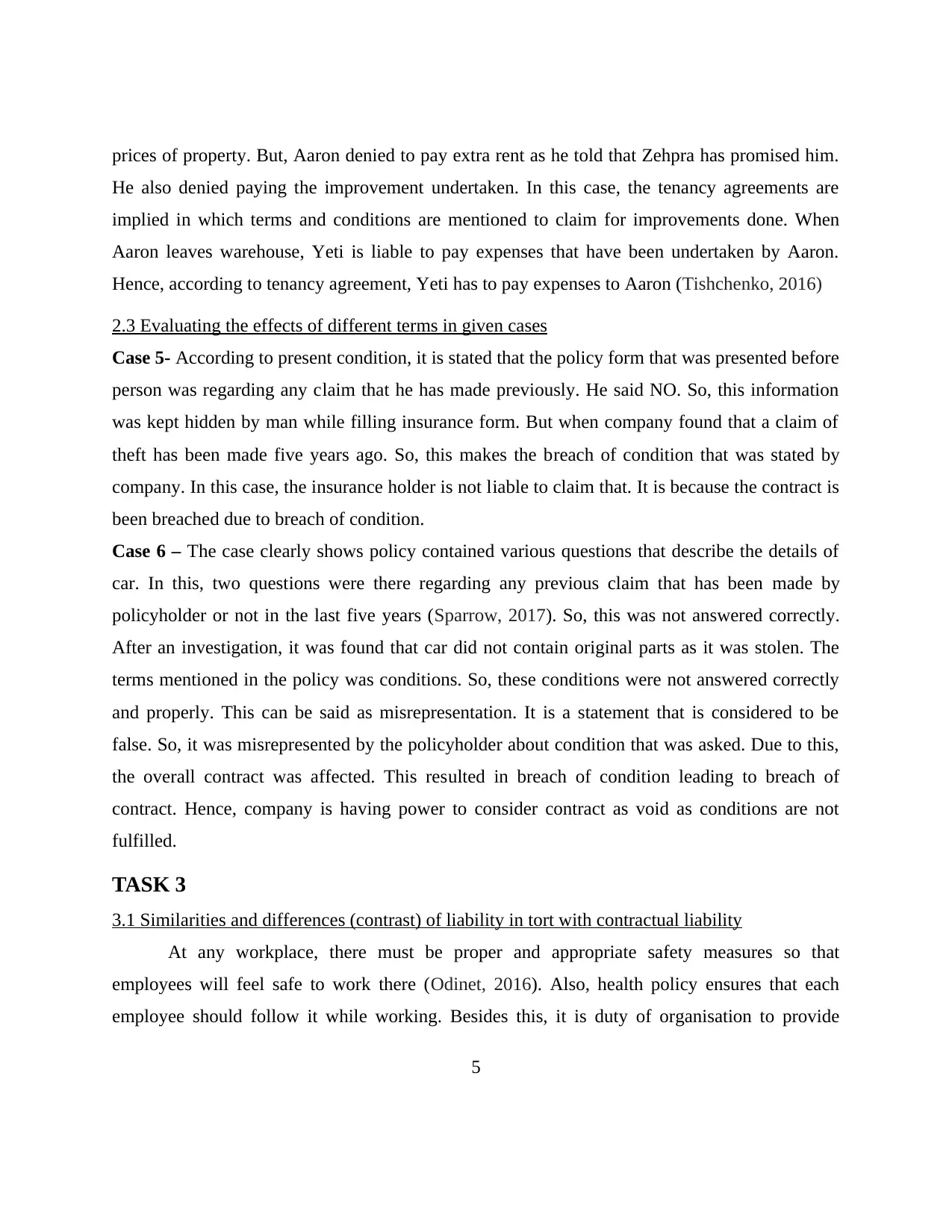
prices of property. But, Aaron denied to pay extra rent as he told that Zehpra has promised him.
He also denied paying the improvement undertaken. In this case, the tenancy agreements are
implied in which terms and conditions are mentioned to claim for improvements done. When
Aaron leaves warehouse, Yeti is liable to pay expenses that have been undertaken by Aaron.
Hence, according to tenancy agreement, Yeti has to pay expenses to Aaron (Tishchenko, 2016)
2.3 Evaluating the effects of different terms in given cases
Case 5- According to present condition, it is stated that the policy form that was presented before
person was regarding any claim that he has made previously. He said NO. So, this information
was kept hidden by man while filling insurance form. But when company found that a claim of
theft has been made five years ago. So, this makes the breach of condition that was stated by
company. In this case, the insurance holder is not liable to claim that. It is because the contract is
been breached due to breach of condition.
Case 6 – The case clearly shows policy contained various questions that describe the details of
car. In this, two questions were there regarding any previous claim that has been made by
policyholder or not in the last five years (Sparrow, 2017). So, this was not answered correctly.
After an investigation, it was found that car did not contain original parts as it was stolen. The
terms mentioned in the policy was conditions. So, these conditions were not answered correctly
and properly. This can be said as misrepresentation. It is a statement that is considered to be
false. So, it was misrepresented by the policyholder about condition that was asked. Due to this,
the overall contract was affected. This resulted in breach of condition leading to breach of
contract. Hence, company is having power to consider contract as void as conditions are not
fulfilled.
TASK 3
3.1 Similarities and differences (contrast) of liability in tort with contractual liability
At any workplace, there must be proper and appropriate safety measures so that
employees will feel safe to work there (Odinet, 2016). Also, health policy ensures that each
employee should follow it while working. Besides this, it is duty of organisation to provide
5
He also denied paying the improvement undertaken. In this case, the tenancy agreements are
implied in which terms and conditions are mentioned to claim for improvements done. When
Aaron leaves warehouse, Yeti is liable to pay expenses that have been undertaken by Aaron.
Hence, according to tenancy agreement, Yeti has to pay expenses to Aaron (Tishchenko, 2016)
2.3 Evaluating the effects of different terms in given cases
Case 5- According to present condition, it is stated that the policy form that was presented before
person was regarding any claim that he has made previously. He said NO. So, this information
was kept hidden by man while filling insurance form. But when company found that a claim of
theft has been made five years ago. So, this makes the breach of condition that was stated by
company. In this case, the insurance holder is not liable to claim that. It is because the contract is
been breached due to breach of condition.
Case 6 – The case clearly shows policy contained various questions that describe the details of
car. In this, two questions were there regarding any previous claim that has been made by
policyholder or not in the last five years (Sparrow, 2017). So, this was not answered correctly.
After an investigation, it was found that car did not contain original parts as it was stolen. The
terms mentioned in the policy was conditions. So, these conditions were not answered correctly
and properly. This can be said as misrepresentation. It is a statement that is considered to be
false. So, it was misrepresented by the policyholder about condition that was asked. Due to this,
the overall contract was affected. This resulted in breach of condition leading to breach of
contract. Hence, company is having power to consider contract as void as conditions are not
fulfilled.
TASK 3
3.1 Similarities and differences (contrast) of liability in tort with contractual liability
At any workplace, there must be proper and appropriate safety measures so that
employees will feel safe to work there (Odinet, 2016). Also, health policy ensures that each
employee should follow it while working. Besides this, it is duty of organisation to provide
5
Paraphrase This Document
Need a fresh take? Get an instant paraphrase of this document with our AI Paraphraser
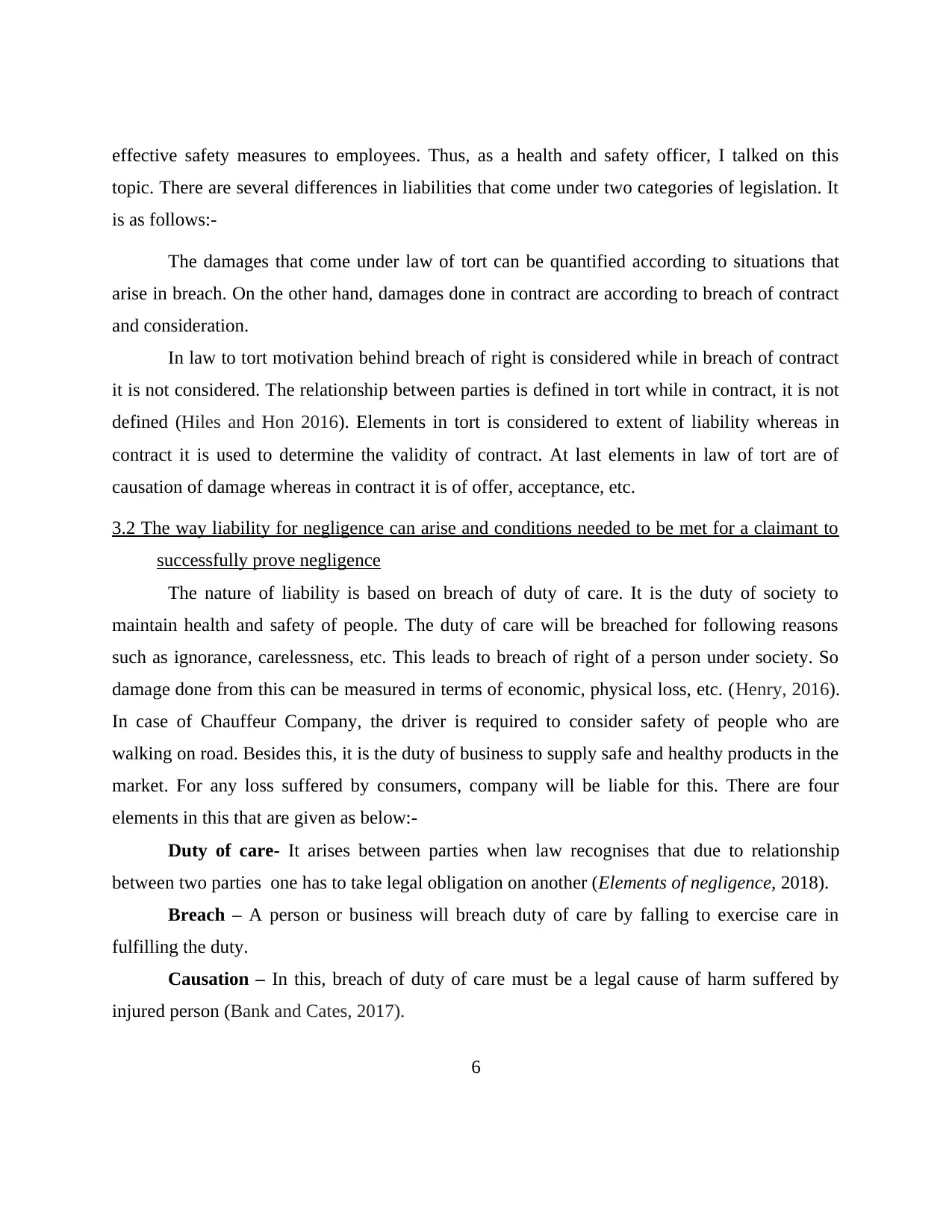
effective safety measures to employees. Thus, as a health and safety officer, I talked on this
topic. There are several differences in liabilities that come under two categories of legislation. It
is as follows:-
The damages that come under law of tort can be quantified according to situations that
arise in breach. On the other hand, damages done in contract are according to breach of contract
and consideration.
In law to tort motivation behind breach of right is considered while in breach of contract
it is not considered. The relationship between parties is defined in tort while in contract, it is not
defined (Hiles and Hon 2016). Elements in tort is considered to extent of liability whereas in
contract it is used to determine the validity of contract. At last elements in law of tort are of
causation of damage whereas in contract it is of offer, acceptance, etc.
3.2 The way liability for negligence can arise and conditions needed to be met for a claimant to
successfully prove negligence
The nature of liability is based on breach of duty of care. It is the duty of society to
maintain health and safety of people. The duty of care will be breached for following reasons
such as ignorance, carelessness, etc. This leads to breach of right of a person under society. So
damage done from this can be measured in terms of economic, physical loss, etc. (Henry, 2016).
In case of Chauffeur Company, the driver is required to consider safety of people who are
walking on road. Besides this, it is the duty of business to supply safe and healthy products in the
market. For any loss suffered by consumers, company will be liable for this. There are four
elements in this that are given as below:-
Duty of care- It arises between parties when law recognises that due to relationship
between two parties one has to take legal obligation on another (Elements of negligence, 2018).
Breach – A person or business will breach duty of care by falling to exercise care in
fulfilling the duty.
Causation – In this, breach of duty of care must be a legal cause of harm suffered by
injured person (Bank and Cates, 2017).
6
topic. There are several differences in liabilities that come under two categories of legislation. It
is as follows:-
The damages that come under law of tort can be quantified according to situations that
arise in breach. On the other hand, damages done in contract are according to breach of contract
and consideration.
In law to tort motivation behind breach of right is considered while in breach of contract
it is not considered. The relationship between parties is defined in tort while in contract, it is not
defined (Hiles and Hon 2016). Elements in tort is considered to extent of liability whereas in
contract it is used to determine the validity of contract. At last elements in law of tort are of
causation of damage whereas in contract it is of offer, acceptance, etc.
3.2 The way liability for negligence can arise and conditions needed to be met for a claimant to
successfully prove negligence
The nature of liability is based on breach of duty of care. It is the duty of society to
maintain health and safety of people. The duty of care will be breached for following reasons
such as ignorance, carelessness, etc. This leads to breach of right of a person under society. So
damage done from this can be measured in terms of economic, physical loss, etc. (Henry, 2016).
In case of Chauffeur Company, the driver is required to consider safety of people who are
walking on road. Besides this, it is the duty of business to supply safe and healthy products in the
market. For any loss suffered by consumers, company will be liable for this. There are four
elements in this that are given as below:-
Duty of care- It arises between parties when law recognises that due to relationship
between two parties one has to take legal obligation on another (Elements of negligence, 2018).
Breach – A person or business will breach duty of care by falling to exercise care in
fulfilling the duty.
Causation – In this, breach of duty of care must be a legal cause of harm suffered by
injured person (Bank and Cates, 2017).
6
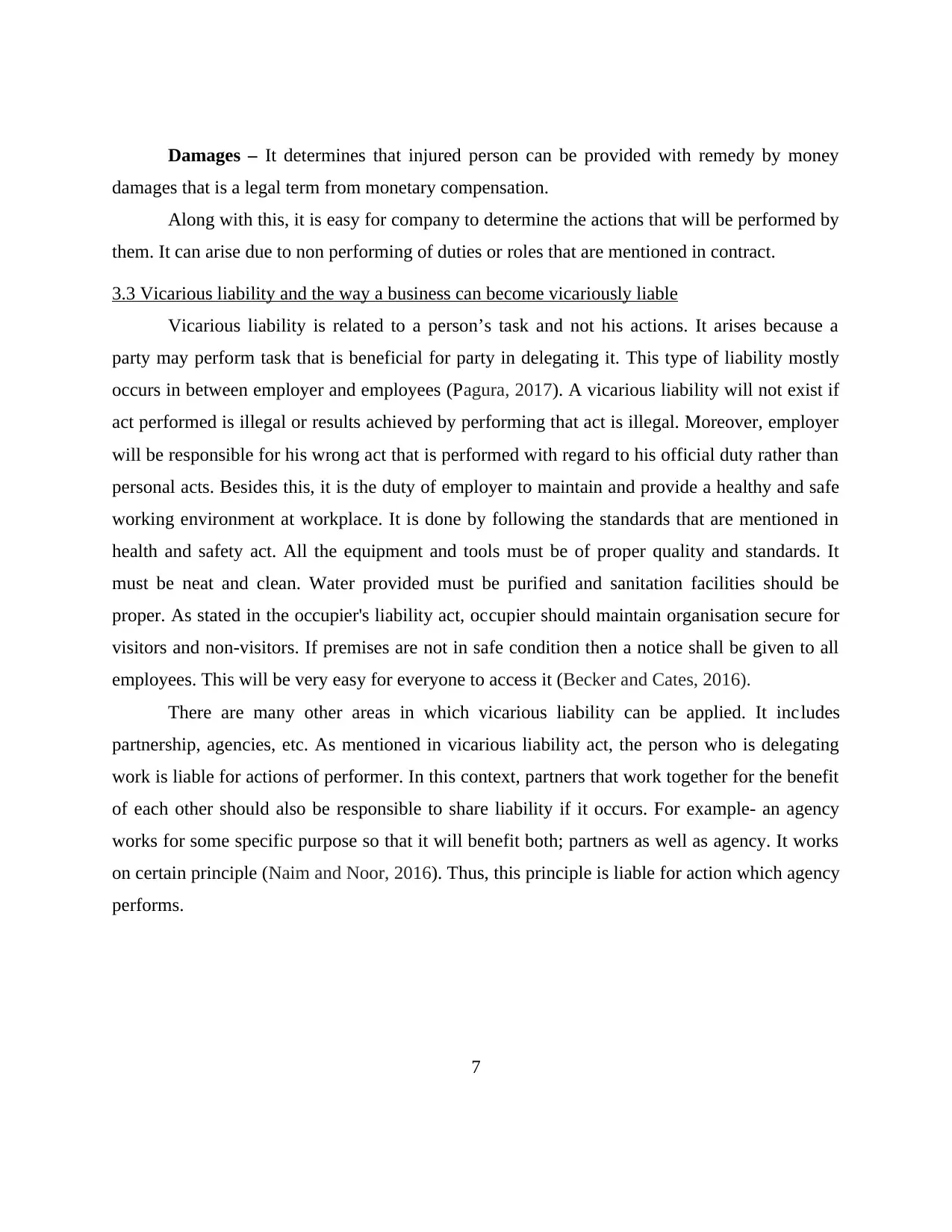
Damages – It determines that injured person can be provided with remedy by money
damages that is a legal term from monetary compensation.
Along with this, it is easy for company to determine the actions that will be performed by
them. It can arise due to non performing of duties or roles that are mentioned in contract.
3.3 Vicarious liability and the way a business can become vicariously liable
Vicarious liability is related to a person’s task and not his actions. It arises because a
party may perform task that is beneficial for party in delegating it. This type of liability mostly
occurs in between employer and employees (Pagura, 2017). A vicarious liability will not exist if
act performed is illegal or results achieved by performing that act is illegal. Moreover, employer
will be responsible for his wrong act that is performed with regard to his official duty rather than
personal acts. Besides this, it is the duty of employer to maintain and provide a healthy and safe
working environment at workplace. It is done by following the standards that are mentioned in
health and safety act. All the equipment and tools must be of proper quality and standards. It
must be neat and clean. Water provided must be purified and sanitation facilities should be
proper. As stated in the occupier's liability act, occupier should maintain organisation secure for
visitors and non-visitors. If premises are not in safe condition then a notice shall be given to all
employees. This will be very easy for everyone to access it (Becker and Cates, 2016).
There are many other areas in which vicarious liability can be applied. It includes
partnership, agencies, etc. As mentioned in vicarious liability act, the person who is delegating
work is liable for actions of performer. In this context, partners that work together for the benefit
of each other should also be responsible to share liability if it occurs. For example- an agency
works for some specific purpose so that it will benefit both; partners as well as agency. It works
on certain principle (Naim and Noor, 2016). Thus, this principle is liable for action which agency
performs.
7
damages that is a legal term from monetary compensation.
Along with this, it is easy for company to determine the actions that will be performed by
them. It can arise due to non performing of duties or roles that are mentioned in contract.
3.3 Vicarious liability and the way a business can become vicariously liable
Vicarious liability is related to a person’s task and not his actions. It arises because a
party may perform task that is beneficial for party in delegating it. This type of liability mostly
occurs in between employer and employees (Pagura, 2017). A vicarious liability will not exist if
act performed is illegal or results achieved by performing that act is illegal. Moreover, employer
will be responsible for his wrong act that is performed with regard to his official duty rather than
personal acts. Besides this, it is the duty of employer to maintain and provide a healthy and safe
working environment at workplace. It is done by following the standards that are mentioned in
health and safety act. All the equipment and tools must be of proper quality and standards. It
must be neat and clean. Water provided must be purified and sanitation facilities should be
proper. As stated in the occupier's liability act, occupier should maintain organisation secure for
visitors and non-visitors. If premises are not in safe condition then a notice shall be given to all
employees. This will be very easy for everyone to access it (Becker and Cates, 2016).
There are many other areas in which vicarious liability can be applied. It includes
partnership, agencies, etc. As mentioned in vicarious liability act, the person who is delegating
work is liable for actions of performer. In this context, partners that work together for the benefit
of each other should also be responsible to share liability if it occurs. For example- an agency
works for some specific purpose so that it will benefit both; partners as well as agency. It works
on certain principle (Naim and Noor, 2016). Thus, this principle is liable for action which agency
performs.
7
⊘ This is a preview!⊘
Do you want full access?
Subscribe today to unlock all pages.

Trusted by 1+ million students worldwide
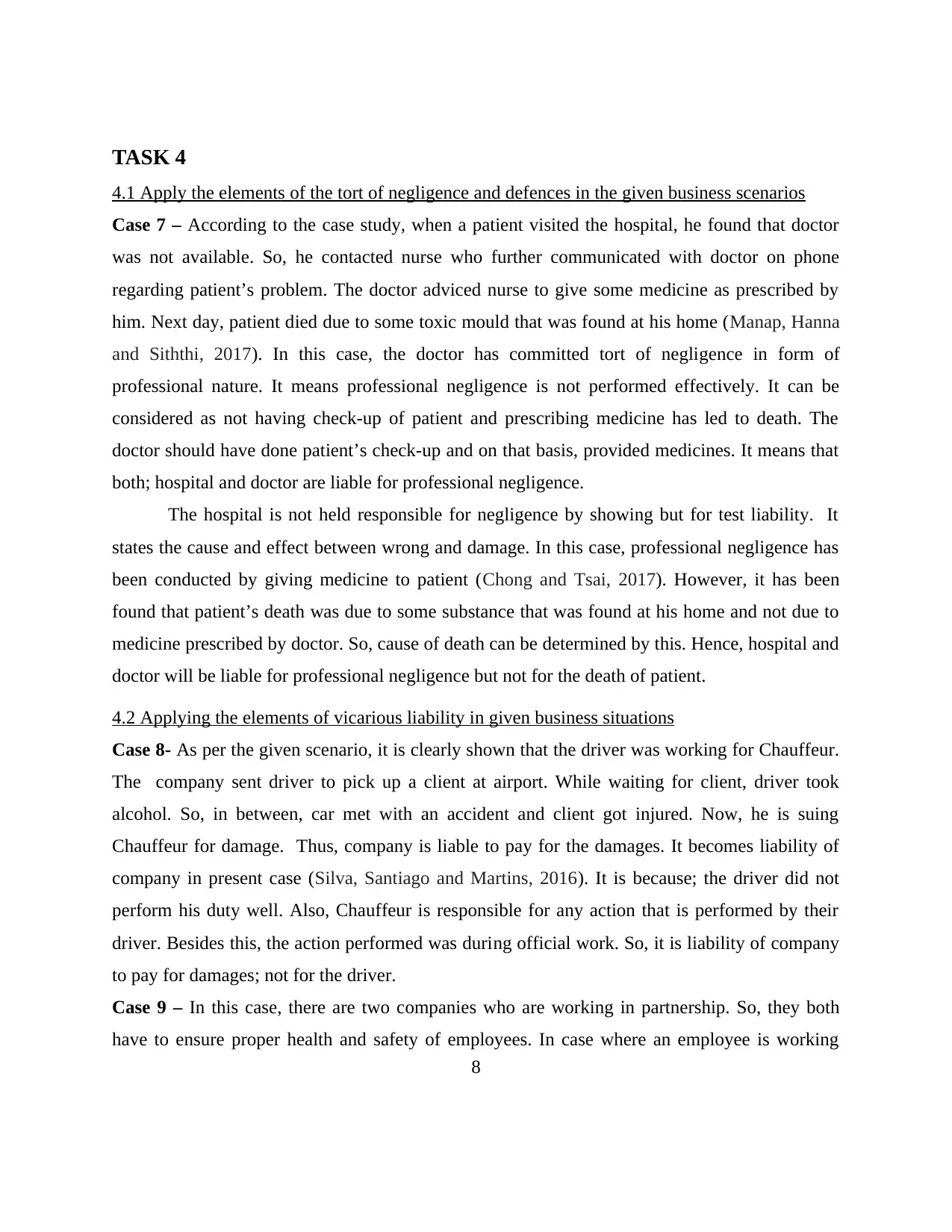
TASK 4
4.1 Apply the elements of the tort of negligence and defences in the given business scenarios
Case 7 – According to the case study, when a patient visited the hospital, he found that doctor
was not available. So, he contacted nurse who further communicated with doctor on phone
regarding patient’s problem. The doctor adviced nurse to give some medicine as prescribed by
him. Next day, patient died due to some toxic mould that was found at his home (Manap, Hanna
and Siththi, 2017). In this case, the doctor has committed tort of negligence in form of
professional nature. It means professional negligence is not performed effectively. It can be
considered as not having check-up of patient and prescribing medicine has led to death. The
doctor should have done patient’s check-up and on that basis, provided medicines. It means that
both; hospital and doctor are liable for professional negligence.
The hospital is not held responsible for negligence by showing but for test liability. It
states the cause and effect between wrong and damage. In this case, professional negligence has
been conducted by giving medicine to patient (Chong and Tsai, 2017). However, it has been
found that patient’s death was due to some substance that was found at his home and not due to
medicine prescribed by doctor. So, cause of death can be determined by this. Hence, hospital and
doctor will be liable for professional negligence but not for the death of patient.
4.2 Applying the elements of vicarious liability in given business situations
Case 8- As per the given scenario, it is clearly shown that the driver was working for Chauffeur.
The company sent driver to pick up a client at airport. While waiting for client, driver took
alcohol. So, in between, car met with an accident and client got injured. Now, he is suing
Chauffeur for damage. Thus, company is liable to pay for the damages. It becomes liability of
company in present case (Silva, Santiago and Martins, 2016). It is because; the driver did not
perform his duty well. Also, Chauffeur is responsible for any action that is performed by their
driver. Besides this, the action performed was during official work. So, it is liability of company
to pay for damages; not for the driver.
Case 9 – In this case, there are two companies who are working in partnership. So, they both
have to ensure proper health and safety of employees. In case where an employee is working
8
4.1 Apply the elements of the tort of negligence and defences in the given business scenarios
Case 7 – According to the case study, when a patient visited the hospital, he found that doctor
was not available. So, he contacted nurse who further communicated with doctor on phone
regarding patient’s problem. The doctor adviced nurse to give some medicine as prescribed by
him. Next day, patient died due to some toxic mould that was found at his home (Manap, Hanna
and Siththi, 2017). In this case, the doctor has committed tort of negligence in form of
professional nature. It means professional negligence is not performed effectively. It can be
considered as not having check-up of patient and prescribing medicine has led to death. The
doctor should have done patient’s check-up and on that basis, provided medicines. It means that
both; hospital and doctor are liable for professional negligence.
The hospital is not held responsible for negligence by showing but for test liability. It
states the cause and effect between wrong and damage. In this case, professional negligence has
been conducted by giving medicine to patient (Chong and Tsai, 2017). However, it has been
found that patient’s death was due to some substance that was found at his home and not due to
medicine prescribed by doctor. So, cause of death can be determined by this. Hence, hospital and
doctor will be liable for professional negligence but not for the death of patient.
4.2 Applying the elements of vicarious liability in given business situations
Case 8- As per the given scenario, it is clearly shown that the driver was working for Chauffeur.
The company sent driver to pick up a client at airport. While waiting for client, driver took
alcohol. So, in between, car met with an accident and client got injured. Now, he is suing
Chauffeur for damage. Thus, company is liable to pay for the damages. It becomes liability of
company in present case (Silva, Santiago and Martins, 2016). It is because; the driver did not
perform his duty well. Also, Chauffeur is responsible for any action that is performed by their
driver. Besides this, the action performed was during official work. So, it is liability of company
to pay for damages; not for the driver.
Case 9 – In this case, there are two companies who are working in partnership. So, they both
have to ensure proper health and safety of employees. In case where an employee is working
8
Paraphrase This Document
Need a fresh take? Get an instant paraphrase of this document with our AI Paraphraser
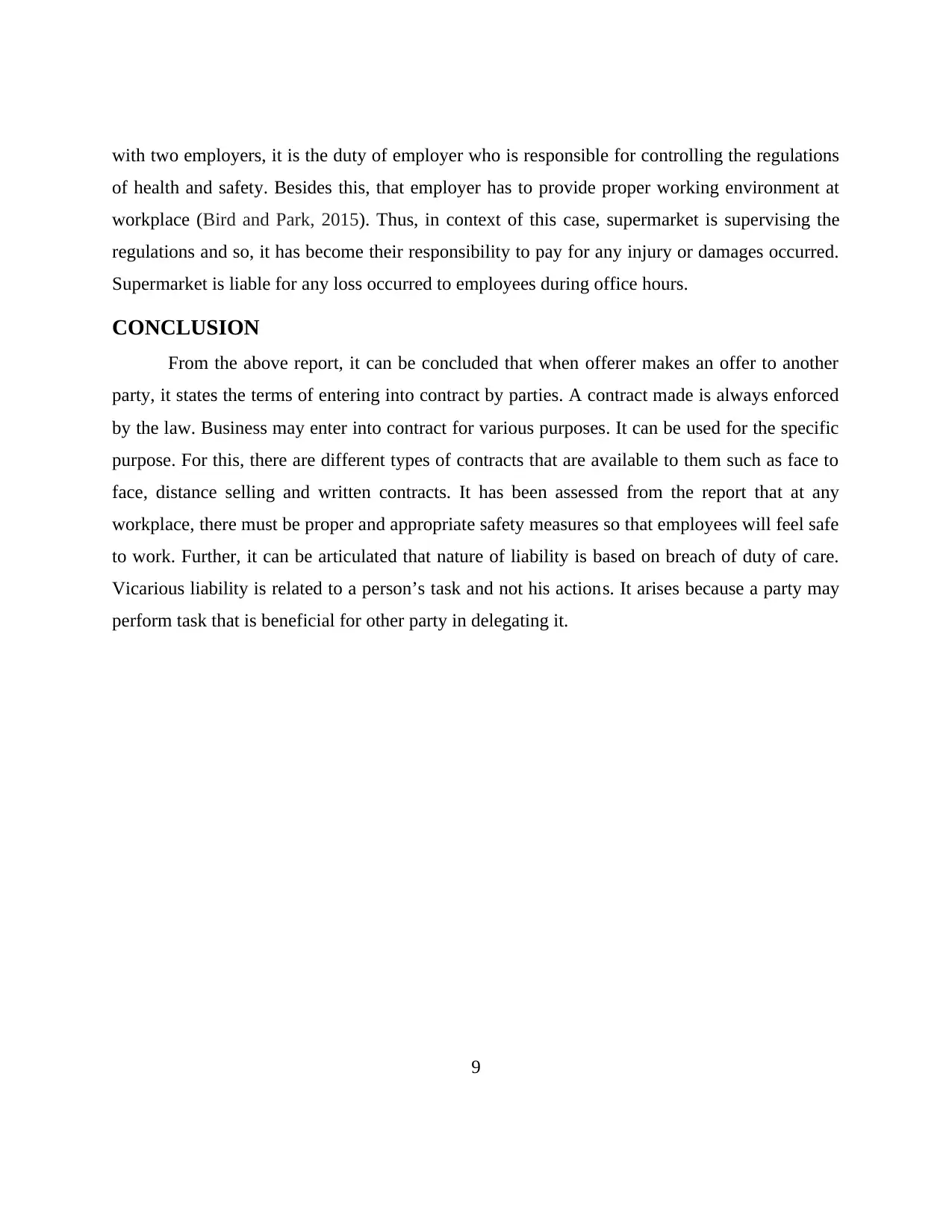
with two employers, it is the duty of employer who is responsible for controlling the regulations
of health and safety. Besides this, that employer has to provide proper working environment at
workplace (Bird and Park, 2015). Thus, in context of this case, supermarket is supervising the
regulations and so, it has become their responsibility to pay for any injury or damages occurred.
Supermarket is liable for any loss occurred to employees during office hours.
CONCLUSION
From the above report, it can be concluded that when offerer makes an offer to another
party, it states the terms of entering into contract by parties. A contract made is always enforced
by the law. Business may enter into contract for various purposes. It can be used for the specific
purpose. For this, there are different types of contracts that are available to them such as face to
face, distance selling and written contracts. It has been assessed from the report that at any
workplace, there must be proper and appropriate safety measures so that employees will feel safe
to work. Further, it can be articulated that nature of liability is based on breach of duty of care.
Vicarious liability is related to a person’s task and not his actions. It arises because a party may
perform task that is beneficial for other party in delegating it.
9
of health and safety. Besides this, that employer has to provide proper working environment at
workplace (Bird and Park, 2015). Thus, in context of this case, supermarket is supervising the
regulations and so, it has become their responsibility to pay for any injury or damages occurred.
Supermarket is liable for any loss occurred to employees during office hours.
CONCLUSION
From the above report, it can be concluded that when offerer makes an offer to another
party, it states the terms of entering into contract by parties. A contract made is always enforced
by the law. Business may enter into contract for various purposes. It can be used for the specific
purpose. For this, there are different types of contracts that are available to them such as face to
face, distance selling and written contracts. It has been assessed from the report that at any
workplace, there must be proper and appropriate safety measures so that employees will feel safe
to work. Further, it can be articulated that nature of liability is based on breach of duty of care.
Vicarious liability is related to a person’s task and not his actions. It arises because a party may
perform task that is beneficial for other party in delegating it.
9
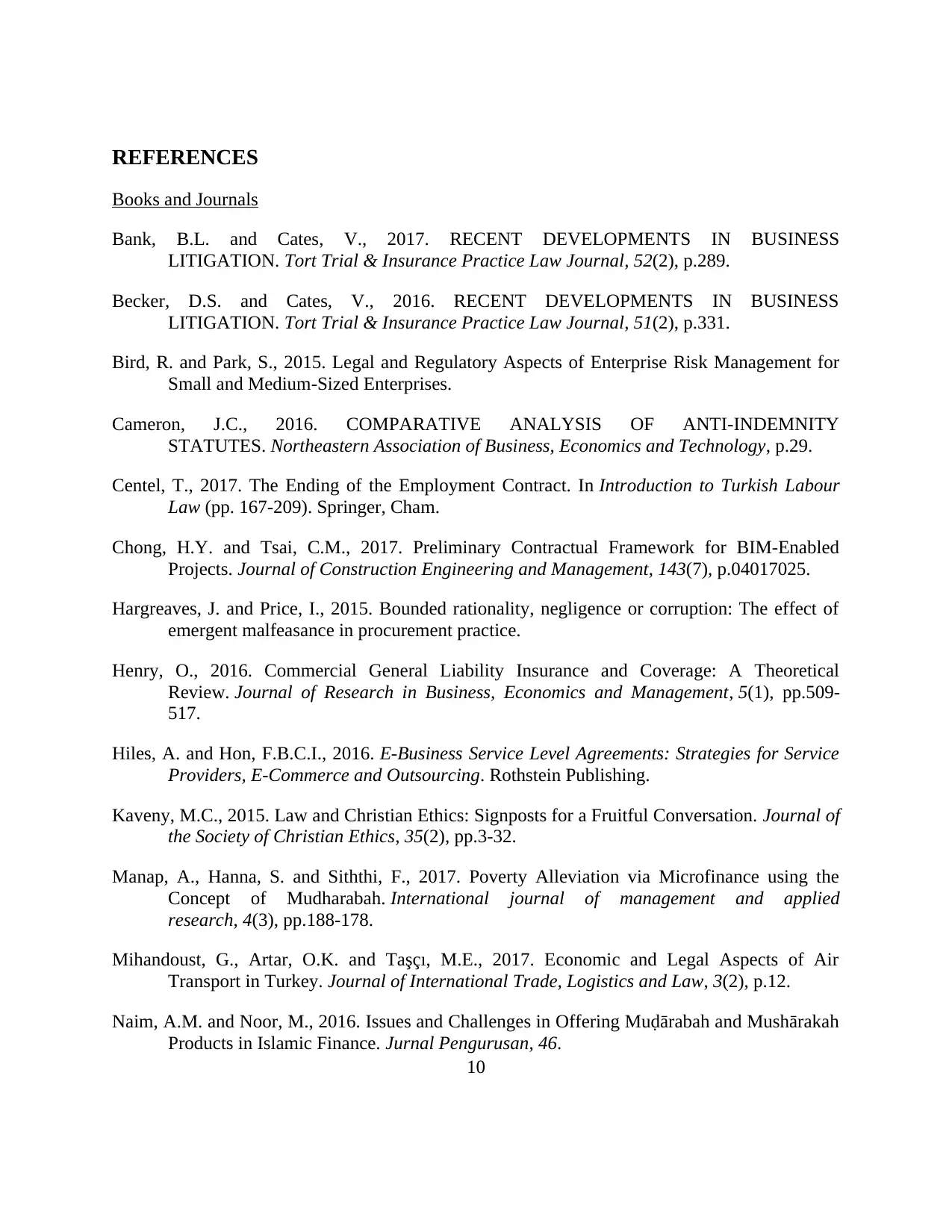
REFERENCES
Books and Journals
Bank, B.L. and Cates, V., 2017. RECENT DEVELOPMENTS IN BUSINESS
LITIGATION. Tort Trial & Insurance Practice Law Journal, 52(2), p.289.
Becker, D.S. and Cates, V., 2016. RECENT DEVELOPMENTS IN BUSINESS
LITIGATION. Tort Trial & Insurance Practice Law Journal, 51(2), p.331.
Bird, R. and Park, S., 2015. Legal and Regulatory Aspects of Enterprise Risk Management for
Small and Medium-Sized Enterprises.
Cameron, J.C., 2016. COMPARATIVE ANALYSIS OF ANTI-INDEMNITY
STATUTES. Northeastern Association of Business, Economics and Technology, p.29.
Centel, T., 2017. The Ending of the Employment Contract. In Introduction to Turkish Labour
Law (pp. 167-209). Springer, Cham.
Chong, H.Y. and Tsai, C.M., 2017. Preliminary Contractual Framework for BIM-Enabled
Projects. Journal of Construction Engineering and Management, 143(7), p.04017025.
Hargreaves, J. and Price, I., 2015. Bounded rationality, negligence or corruption: The effect of
emergent malfeasance in procurement practice.
Henry, O., 2016. Commercial General Liability Insurance and Coverage: A Theoretical
Review. Journal of Research in Business, Economics and Management, 5(1), pp.509-
517.
Hiles, A. and Hon, F.B.C.I., 2016. E-Business Service Level Agreements: Strategies for Service
Providers, E-Commerce and Outsourcing. Rothstein Publishing.
Kaveny, M.C., 2015. Law and Christian Ethics: Signposts for a Fruitful Conversation. Journal of
the Society of Christian Ethics, 35(2), pp.3-32.
Manap, A., Hanna, S. and Siththi, F., 2017. Poverty Alleviation via Microfinance using the
Concept of Mudharabah. International journal of management and applied
research, 4(3), pp.188-178.
Mihandoust, G., Artar, O.K. and Taşçı, M.E., 2017. Economic and Legal Aspects of Air
Transport in Turkey. Journal of International Trade, Logistics and Law, 3(2), p.12.
Naim, A.M. and Noor, M., 2016. Issues and Challenges in Offering Muḍārabah and Mushārakah
Products in Islamic Finance. Jurnal Pengurusan, 46.
10
Books and Journals
Bank, B.L. and Cates, V., 2017. RECENT DEVELOPMENTS IN BUSINESS
LITIGATION. Tort Trial & Insurance Practice Law Journal, 52(2), p.289.
Becker, D.S. and Cates, V., 2016. RECENT DEVELOPMENTS IN BUSINESS
LITIGATION. Tort Trial & Insurance Practice Law Journal, 51(2), p.331.
Bird, R. and Park, S., 2015. Legal and Regulatory Aspects of Enterprise Risk Management for
Small and Medium-Sized Enterprises.
Cameron, J.C., 2016. COMPARATIVE ANALYSIS OF ANTI-INDEMNITY
STATUTES. Northeastern Association of Business, Economics and Technology, p.29.
Centel, T., 2017. The Ending of the Employment Contract. In Introduction to Turkish Labour
Law (pp. 167-209). Springer, Cham.
Chong, H.Y. and Tsai, C.M., 2017. Preliminary Contractual Framework for BIM-Enabled
Projects. Journal of Construction Engineering and Management, 143(7), p.04017025.
Hargreaves, J. and Price, I., 2015. Bounded rationality, negligence or corruption: The effect of
emergent malfeasance in procurement practice.
Henry, O., 2016. Commercial General Liability Insurance and Coverage: A Theoretical
Review. Journal of Research in Business, Economics and Management, 5(1), pp.509-
517.
Hiles, A. and Hon, F.B.C.I., 2016. E-Business Service Level Agreements: Strategies for Service
Providers, E-Commerce and Outsourcing. Rothstein Publishing.
Kaveny, M.C., 2015. Law and Christian Ethics: Signposts for a Fruitful Conversation. Journal of
the Society of Christian Ethics, 35(2), pp.3-32.
Manap, A., Hanna, S. and Siththi, F., 2017. Poverty Alleviation via Microfinance using the
Concept of Mudharabah. International journal of management and applied
research, 4(3), pp.188-178.
Mihandoust, G., Artar, O.K. and Taşçı, M.E., 2017. Economic and Legal Aspects of Air
Transport in Turkey. Journal of International Trade, Logistics and Law, 3(2), p.12.
Naim, A.M. and Noor, M., 2016. Issues and Challenges in Offering Muḍārabah and Mushārakah
Products in Islamic Finance. Jurnal Pengurusan, 46.
10
⊘ This is a preview!⊘
Do you want full access?
Subscribe today to unlock all pages.

Trusted by 1+ million students worldwide
1 out of 13
Related Documents
Your All-in-One AI-Powered Toolkit for Academic Success.
+13062052269
info@desklib.com
Available 24*7 on WhatsApp / Email
![[object Object]](/_next/static/media/star-bottom.7253800d.svg)
Unlock your academic potential
Copyright © 2020–2025 A2Z Services. All Rights Reserved. Developed and managed by ZUCOL.





